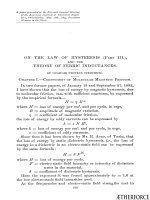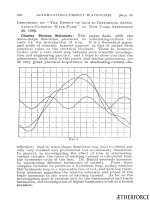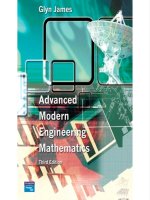steinmetz cp engineering mathematics
Bạn đang xem bản rút gọn của tài liệu. Xem và tải ngay bản đầy đủ của tài liệu tại đây (20.63 MB, 319 trang )
ÆTHERFORCE
ENGfflEEMG
MATHEMATICS
A
SERIES
OF
LECTURES
DELIVERED
AT UNION
COLLEGE
BY
CHARLES PROTEUS
STEIMET2,
A.M.,
Pn.D.
PAST
TKKSIDFNT
UIFIMC'
V\
INSTITUTE
OF
LLLCTRICVL
LXGINLERS
McGRAW-HILL
BOOK
COMPANY
239
WEST 39TH
STREET,
NEW
YORK
6
BOUVERIE
STEEET, LONDON,
E.G.
1911
ÆTHERFORCE
Copyright,
JO
11,
BV
McGRAW-lIILL
BOOK COMPANY
ÆTHERFORCE
PREFACE.
THE
following
work
embodies the
subject-matter
of
a lecture
course
which I
have
given
to
the
junior
and
senior
electrical
engineering
students of Union
University
for
a number
of
years.
It
is
generally
conceded that
a
fair
knowledge
of
mathe-
matics is
necessary
to the
engineer,
and
especially
the
electrical
engineer.
For
the
latter, however,
some
branches of
mathe-
matics
are
of
fundamental
importance,
as the
algebra
of
the
general
number,
the
exponential
and
trigonometric
series,
etc.,
which are
seldom
adequately
treated,
and
often not
taught
at
all
in
the usual
text-books
of
mathematics,
or
in
the
college
course of
analytic geometry
and
calculus
given
to
the
engineer-
ing
students, and,
therefore,
electrical
engineers
often
possess
little
knowledge
of
these
subjects.
As
the
result,
an electrical
engineer,
even
if
he
possess
a
fail'
knowledge
of
mathematics,
may
often
find
difficulty
in
dealing
with
problems, through
lack
of
familiarity
with
these
branches
of
mathematics,
which have
become
of
importance
in electrical
engineering,
and
may
also
find
difficulty
in
looking
up
information
on these
subjects.
In
the
same
way
the
college
student,
when
beginning
the
study
of electrical
engineering
theory,
after
completing
his
general
course
of
mathematics, frequently
finds' himself
sadly
deficient
in the
knowledge
of mathematical
subjects,
of
which
a
complete
familiarity
is
required
for effective
understanding
of
electrical
engineering
theory.
It
was
this
experience
which
led
me some
years
ago
to start
the course
of lectures
which
is
reproduced
in the
following pages.
I have thus
attempted
to
bring together
and
discuss
explicitly,
with numerous
practical
applications,
all those
branches
of
mathematics
which are of
special
importance
to the electrical
engineer.
Added
thereto
ÆTHERFORCE
vi
PKEIWE.
are
a number
of
subjects
which
experience
has shown
me
to
be
important
for the effective
and
expeditious
execution
of
electrical
engineering
calculations.
Merc
theoretical
knowledge
of mathematics
is
not
sufficient
for the
engineer,
but
it
must
be
accompanied
by
ability
to
apply
it
and
derive resultsto
carry
out
numerical calculations.
It
is
not
sufficient
to
know
how
a
phenomenon
occurs,
and how
it
may
be
calculated,
but
very
often there
is
a wide
gap
between
this
knowledge
and the
ability
to
carry
out
the
calculation; indeed,
frequently
an
attempt
to
apply
the
theoretical
knowledge
to
derive numerical
results
leads,
even
in
simple problems,
to
apparently
hopeless
complication
and almost
endless
calculation,
so
that
all
hope
of
getting
reliable
results
vanishes.
Thus
considerable
space
has
been devoted
to the
discussion
of methods
of
calculation,
the
use
of curves
and
their
evaluation,
and
other
kindred
subjects
requisite
for effective
engineering
work,
Thus the
following
work
is
not intended as a
complete
course
in
mathematics,
but
as
supplementary
to
the
general
college
course
of
mathematics,
or
to
the
general knowledge
of
mathematics
which
every
engineer
and
really every
educated
man
should
possess.
In
illustrating
the mathematical
discussion,
practical
examples,
usually
taken
from the
field
of
electrical
engineer-
ing,
have
been
given
and
discussed.
These
are
sufficiently
numerous
that
any
example
dealing
with
a
phenomenon
with which the
reader
is not
yet
familiar
may
be
omitted
and
taken
up
at
a
later
time.
As
appendix
is
given
a
descriptive
outline
of the intro-
duction
to
the
theory
of
functions,
since
the
electrical
engineer
should
be familiar
with
the
general
relations between
the
different functions
which
he meets.
In relation
to
"
Theoretical Elements
of Electrical
Engineer-
ing/'
"Theory
and Calculation
of
Alternating
Current
Phe-
nomena/
7
and
"
Theory
and
Calculation of
Transient Electric
Phenomena/'
the
following
work is intended
as
an
introduction
and
explanation
of
the
mathematical
side,
and the most
efficient
method
of
study,
appears
to
me,
to
start
with
"
Electrical
Engineering
Mathematics,"
and
after
entering
its
third
chapter,
to
take
up
the
reading
of
the
first
section
of
"
Theo-
retical
Elements,"
and
then
parallel
the
study
of
"
Electrical
ÆTHERFORCE
PREFACE.
vii
Engineering Mathematics/'
"
Theoretical
Elements of
Electrical
Engineering/'
and
"
Theory
and
Calculation
of
Alternating
Current
Phenomena/'
together
with
selected
chapters
from
"Theory
and
Calculation of
Transient Electric
Phenomena/'
and
after
this,
once
more
systematically go through
all
four
books.
CHARLES P.
STEINMETZ.
SCHENECTADY,
N.
Y.,
December,
1910,
ÆTHERFORCE
ÆTHERFORCE
CONTENTS.
PAGE
PREFACE
v
CHAPTER
I.
THE
GENERAL
NUMBER.
A.
THE
SYSTEM OF
NUMBERS.
1.
Addition and
Subtraction.
Origin
of
numbers.
Counting
and
measuring.
Addition.
Subtraction
as
reverse
operation
of
addition
1
2.
Limitation
of
subtraction.
Subdivision
of
the
absolute
numbers
into
positive
and
negative
2
3.
Negative
number a
mathematical
conception
like
the
imaginary
number.
Cases
where the
negative
number
has
a
physical
meaning,
and
cases where
it has
not
4
4.
Multiplication
and
Division.
Multiplication
as
multiple
addi-
tion, Division as
its reverse
operation.
Limitation
of divi-
sion
6
5.
The fraction as
mathematical
conception.
Cases where
it
has
a
physical meaning,
and
cases where
it
has not
8
C.
Involution
and
Evolution. Involution
as
multiple multiplica-
tion.
Evolution
as its reverse
operation.
Negative expo-
nents
9
7.
Multiple
involution
leads
to
no
new
operation
10
8.
Fractional
exponents
10
9. Irrational
Numbers.
Limitation
of
evolution. Endless
decimal
fraction.
Rationality
of
the
irrational number
11
10.
Quadrature
numbers.
Multiple
values
of
roots.
Square
root
of
negative quantity representing quadrature
number,
or rota-
tion
by
90
13
H.
Comparison
of
positive,
negative
and
quadrature
numbers.
Reality
of
quadrature
number.
Cases
where it has a
physical
meaning,
and
cases where
it has not 14
12. General
Numbers.
Representation
of
the
plane by
the
general
number.
Its
relation
to
rectangular
coordinates 16
13. Limitation
of
algebra
by
the
general
number.
Roots
of
the unit.
Number
of
such
roots,
and
their
relation
18
14.
The two
reverse
operations
of
involution
19
ix
ÆTHERFORCE
x CONTENTS.
PAGE
15.
Logarithmation.
Relation
between
logarithm
and
exponent
of
involution.
Reduction
to
other
base.
Logarithm
of
negative
quantity
20
16.
Quaternions.
Vector
calculus
of
space
22
17.
Space
rotors
and their
relation.
Super
algebraic
nature
of
space
analysis
,
22
B.
ALGEBRA
OF
THE
GENERAL
NUMBER
OF
COMPLEX
QUANTITY.
Rectangular
and
Polar Coordinates
.
.
25
IS.
Powers
of
j.
Ordinary
or
real,
and
quadrature
or
imaginary
number.
Relations
25
19.
Conception
of
general
number
by
point
of
plane
in
rectangular
coordinates;
in
polar
coordinates.
Relation between
rect-
angular
and
polar
form 26
20.
Addition
and Subtraction.
Algebraic
and
geometrical
addition
and subtraction.
Combination
and
resolution
by parallelo-
gram
law 28
21. Denotations
30
22.
Sign
of
vector
angle.
Conjugate
and
associate numbers.
Vec-
tor
analysis
30
23.
Instance
of steam
path
of
turbine
33
24.
Multiplication.
Multiplication
in
rectangular
coordinates. 38
25.
Multiplication
in
polar
coordinates.
.
Vector
and
operator
38
26.
Physical
meaning
of
result
of
algebraic
operation.
Representa-
tion
of
result
40
27. Limitation
of
application
of
algebraic
operations
to
physical
quantities,
and
of
the
graphical
representation
of
the
result.
Graphical
representation
of
algebraic
operations
between
current,
voltage
and
impedance
40
28.
Representation
of
vectors
and of
operators
42
29.
Division.
Division in
rectangular
coordinates
42
30.
Division
in
polar
coordinates
43
31.
Involution
and
Evolution.
Use
of
polar
coordinates
44
32.
Multiple
values
of
the result
of
evolution.
Their
location
in
the
plane
of
the
general
number.
Polyphase
and
n
phase
systems
of
numbers
45
33. The
n
values
of
Vl and their
relation
46
34. Evolution
in
rectangular
coordinates.
Complexity
of
result
47
35. Reduction
of
products
and
fractions
of
general
numbers
by
polar
representation.
Instance
48
36.
Exponential representations
of
general
numbers.
The
different
forms
of
the
general
number
49
37.
Instance
of
use
of
exponential
form in
solution of
differential
equation
50
ÆTHERFORCE
CONTENTS.
xi
PAGE
38.
Logarithmation,
Resolution of
the
logarithm
of
a
general
number
51
CHAPTER
II, THE
POTENTIAL
SERIES
AND
EXPONENTIAL
FUNCTION.
A.
GENERAL,
39 The
infinite
series of
powers
of
a;
52
40.
Approximation by
series
53
41.
Alternate and
one-sided
approximation
54
42.
Convergent
and
divergent
series
55
43.
Range
of
convergency.
Several
series
of
different
ranges
for
same
expression
56
44
Discussion
of
convergency
in
engineering
applications
,
.
57
45. Use of
series
for
approximation
of
small
terms.
Instance
of
electric
circuit
58
46. Binomial theorem
for
development
in
series.
Instance
of
in-
ductive
circuit
59
47.
Necessity
of
development
in
series.
Instance
of
a,rc of
hyperbola
60
48.
Instance
of
numerical calculation
of
log
(1
-fa;)
63
B. DIFFERENTIAL
EQUATIONS,
49.
Character
of most
differential
equations
of
electrical
engineering,
Their
typical
forms
64
dy
50.
-j il'
Solution
by
scries, by
method
of
indeterminate co-
dx
efficients
,
65
dz
51.
7-
az.
Solution
by
indeterminate coefficients
68
dx
52.
Integration
constant and
terminal
conditions
68
53.
Involution
of
solution.
Exponential
function
70
54.
Instance
of
rise
of
field current
in
direct
current shunt
motor
. .
72
55.
Evaluation
of
inductance,
and numerical
calculation 75
56.
Instance
of
condenser
discharge through
resistance 76
$y
57.
Solution
Qt-=ay
by
indeterminate
coefficients,
by
exponential
function
,
78
58.
Solution
by
trigonometric
functions
,
.
.
,
81
59.
Relations
between
trigonometric
functions
and
exponential
func-
tions
with
imaginary
exponent,
and
inversely
83
60.
Instance
of condenser
discharge
through
inductance.
The
two
integration
constants
and terminal conditions
84
61.
Effect
of resistance
on the
discharge.
The
general
differential
equation
86
ÆTHERFORCE
xii
CONTENTS.
PAGE
62.
Solution
of
the
general
differential
equation
by
means
of
the
exponential
function,
by
the
method
of indeterminate
coefficients
86
63.
Instance
of
condenser
discharge
through
resistance
and induc-
tance.
Exponential
solution
and
evaluation
of
constants.
.
88
64.
Imaginary
exponents
of
exponential
functions.
Reduction
to
trigonometric
functions.
The
oscillating
functions 91
65
Explanation
of tables
of
exponential
functions)
, .
.
92
CHAPTER
m.
TRIGONOMETRIC
SERIES
A.
TRIGONOMETRIC
FUNCTIONS.
66.
Definition
of
trigonometric
functions
on circle
and
right
triangle
94
67.
Sign
of
functions
in different
quadrants
95
68. Relations
between
sm,
cos,
tan
and cot
-
-
. . 97
69.
Negative, supplementary
and
complementary
angles
98
/ A
70.
Angles
(xn)
and (
x- 1
100
71. Relations
between
two
angles,
and
between
angle
and double
angle
302
72.
Differentiation
and
integration
of
trigonometric
functions.
Definite
integrals
103
73.
The binomial
relations
104
74.
Polyphase
relations
104
75
Trigonometric
formulas
of
the
triangle
105
13.
TRIGONOMETRIC
SERIES.
76.
Constant,
transient
and
periodic
phenomena.
Univalent
peri-
odic
function
represented
by
trigonometric
series
106
77
Alternating
sine
waves
and
distorted
'waves
107
78.
Evaluation
of
the
Constants
from
Instantaneous
Values.
Cal-
culation
of constant
term
of
series
108
79.
Calculation
of
cos-coefficients
,
110
80.
Calculation
of
sin-coefficients
113
81. Instance
of
calculating
llth
harmonic of
generator
wave
114
82.
Discussion.
Instance
of
complete
calculation
of
pulsating
cur-
rent
wave
116
83.
Alternating
waves
as
symmetrical
waves.
Calculation
of
sym-
metrical
wave
,
117
84.
Separation
of
odd
and even
harmonics
and
of
constant
term
120
85.
Separation
of
sine and cosine
components
121
*86.
Separation
of
wave
into constant
term and
4
component
waves 122
87.
Discussion
of
calculation
123
88.
Mechanism
of calculation
124
ÆTHERFORCE
CONTENTS.
xiii
PAGE
89.
Instance
of
resolution
of
the
annual
temperature
curve 125
90.
Constants and
equation
of
temperature
wave
131
91. Discussion
of
temperature
wave
132
C.
REDUCTION
OF
TRIGONOMETRIC SERIES BY
POLYPHASE
RELATION.
92.
Method
of
separating
cm-tain classes
of
harmonics,
and
its
limitation
134
93. Instance
of
separating
the
3d
and 9th harmonic of
transformer
exciting
current
136
D.
CALCULATION
OF
TRIGONOMETRIC
SEEIES
FROM
OTHER TRIGONO-
,
METRIC
SERIES,
94.
Instance
of
calculating
current
in
long
distance transmission
line,
due to
distorted
voltage
wave
of
generator.
Line
constants 139
95.
Circuit
equations,
and
calculation
of
equation
of
current
141
96.
Effective
value
of
current,
and
comparison
with
the current
produced by
sine wave
of
voltage
143
97.
Voltage
wave
of
reactance
in
circuit
of
this
distorted
current
.
145
CHAPTER
IV. MAXIMA
AND
MINIMA
98. Maxima
and
minima
by
curve
plotting.
Instance of
magnetic
permeability.
Maximum
power
factor
of
induction
motor as
function
of
load
147
99.
Interpolation
of maximum
value
in
method
of
curve
plotting.
Error
in
case
of
unsymmetrical
curve,
Instance of
efficiency
of
steam
turbine
nozzle.
Discussion
149
100.
Mathematical
method.
Maximum,
minimum and
inflexion
point.
Discussion 152
101. Instance:
Speed
of
impulse
turbine
wheel
for
maximum
efficiency.
Current
in
transformer
for
maximum
efficiency.
154
102.
Effect
of
intermediate
variables. Instance: Maximum
power
in
resistance
shunting
a constant
resistance
in a
constant
cur-
rent
circuit
155
103.
Simplification
of calculation
by
suppression
of
unnecessary terms,
etc.
Instance
157
104.
Instance:
Maximum
non-inductive
load
on
inductive
transmis-
sion
line.
Maximum current
in
line 158
105.
Discussion
of
physical
meaning
of
mathematical
extremum.
Instance
160
106.
Instance:
External
reactance
giving
maximum
output
of
alter-
nator
at constant
external resistance
and
constant
excitation.
Discussion
161
107.
Maximum
efficiency
of
alternator
on
non-inductive
load.
Dis-
cussion
of
physical
limitations
162
ÆTHERFORCE
xiv
CONTENTS,
P*B
108. Fuxtrema
with several
independent
variables.
Method
of
math-
ematical
calculation,
and
geometrical
meaning
163
109. Resistance
and reactance
of
load
to
give
maximum
output
of
transmission
line,
at
constant
supply
voltage
1
65
110.
Discussion
of
physical
limitations
167
111. Determination
of
extrema
by
plotting
curve
of
differential
quo-
tient.
Instance:
Maxima
of
current
wave
of
alternator
of
distorted
voltage
on transmission
line
168
112.
Graphical
calculation
of
differential
curve
of
empirical
curve,
for
determining
extrcrna
170
113.
Instance:
Maximum
permeability
calculation
170
114.
Grouping
of
battery
cells
for
maximum
power
in
constant resist-
ance
171
115.
Voltage
of
transformer
to
give
maximum
output
at constant
loss
173
116.
Voltage
of
transformer,
at constant
output,
to
give
maximum
efficiency
at full
load,
at
half
load
174
117.
Maximum value
of
charging
current
of
condenser
through
inductive circuit
(a)
at
low
resistance
;
(b)
at
high
resistance.
175
118.
At
what
output
is
the
efficiency
of an
induction
generator
a max-
imum
9
177
119.
Discussion
of
physical
limitations. Maximum
efficiency
at
con-
stant current
output
178
120.
METHOD
OF
LEAST
SQUARES.
Relation
of number
of
observa-
tions to
number
of
constants. Discussion
of
errors
of
observation
179
121.
Probability
calculus
and
the
minimum
sum
of
squares
of
1 he-
errors
'
1SI
122.
The
differential
equations
of
the
sum
of
least
squares
182
123.
Instance: Reduction
of
curve
of
power
of
induction
motor
running
light,
into the
component
losses.
Discussion
of
results
'
182
CHAPTER V.
METHODS OF
APPROXIMATION
124.
Frequency
of
small
quantities
in
electrical
engineering
problems.
Instances.
Approximation by
dropping
terms
of
higher
order. 1S7
125.
Multiplication
of
terms
with small
quantities
188
126.
Instance
of
calculation
of
power
of
direct
current
shunt
motor
.
189
1 27.
Small
quantities
in
denominator
of
fractions
190
128.
Instance
of
calculation
of
induction
motor
current,
as
function
of
slip 191
ÆTHERFORCE
CONTENTS,
xv
P4GB
129. Use
of binomial
series
in
approximations
of
powers
and
roots,
and
in
numerical
calculations
193
130.
Instance
of
calculation
of
current
in
alternating
circuit of low
inductance.
Instance
of
calculation
of
short
circuit
current
of
alternator,
as
function
of
speed
195
131.
Use
of
exponential
series
and
logarithmic
scries
in
approxima-
tions
196
132.
Approximations
of
trigonometric
functions
198
133. McLaurin's and
Taylor's
series in
approximations
.198
134. Tabulation
of
various infinite series and of
the
approximations
derived
from
them
.
190
135. Estimation
of
accuracy
of
approximation.
Application
to
short
circuit current
of
alternator
200
136.
Expressions
which are
approximated
by
(1 +)
and
by
(1
-s)
201
137. Mathematical
instance
of
approximation
203
138.
EQUATIONS
OP THE TRANSMISSION LINE.
Integration
of
the
differential
equations
.
.
. 204
139.
Substitution
of
the terminal
conditions
205
140. The
approximate equations
of
the transmission line
206
141.
Numerical instance.
Discussion of
accuracy
of
approxima-
tion
. .
207
CHAPTER VI.
EMPIRICAL CURVES
A. GENERAL.
142.
Relation between
empirical
curves,
empirical
equations
and
rational
equations
,
209
143.
Physical
nature
of
phenomenon.
Points
at
aero and
at
infinity.
Periodic
or
non-periodic.
Constant terms.
Change
of
curve
law. Scale 210
B. NON-PERIODIC
CORVES,
144.
Potential
Scries. Instance
of
core-loss
curve
212
145.
Rational
and irrational
use
of
potential
series. Instance
of
fan
motor
torque.
Limitations
of
potential
series 214
146. PARABOLIC
AND HYPERBOLIC
CURVES. Various
shapes
of
para-
bolas and
of
hyperbolas
. .
216
147.
The
characteristic
of
parabolic
and
hyperbolic
curves.
Its
use
and limitation
by
constant
terms
223
148.
The
logarithmic
characteristic.
Its use
and
limitation
224
149.
EXPONENTIAL
AND LOGARITHMIC
CURVES.
The
exponential
function
226
150.
Characteristics
of
the
exponential
curve,
their
use and
limitation
by
constant
term.
Comparison
of
exponential
curve
and
hyperbola
227
ÆTHERFORCE
xvi CONTENTS.
PAGE
151.
Double
exponentialfunctions,
Various
shapes
thereof
.
.
229
152.
EVALUATION
OP EMPIRICAL
CTJBYES,
General
principles
of
investigation
of
empirical
curves
.232
153.
Instance:
The
volt-ampere
charactenstic
of the
tungbten
lamp,
reduced to
parabola
with
exponent
0.6. Rationalized
by
reduction
to
radiation
law
.
333
154. The
volt-ampere
characteristic
of
the
magnetite
arc,
reduced
to
hyperbola
with
exponent
0.5
236
155.
Change
of
electric
current with
change
of
circuit
conditions,
reduced to
double
exponential
function
of
time
339
356.
Rational
reduction
of core-loss
curve
of
paragraph
144,
by
parabola
with
exponent
1.6
242
157.
Reduction
of
magnetic
characteristic
1
,
for
higher
densities,
to
hyperbolic
curve
. .
244
C. PERIODIC
CURVES.
158. Distortion
of
pine
wave
by
lower
harmonics
246
159.
Ripples
and
nodes
caused
by
higher
harmonics.
Incommen-
surable
waves
.
24C
CHAPTER VII.
NUMERICAL
CALCULATIONS
1
60.
METHOD
OF
CALCULATION.
Tabular
form
of
calculation.
249
161.
Instance
of
transmission
line
regulation
251
162. EXACTNESS
OF
CALCULATION.
Degrees
of
exactness:
magni-
tude,
approximate,
exact
252
163.
Number
of
decimals
254
164.
INTELLIGIBILITY
OF ENGINEERING
DATA.
Curve
plotting
for
showing
shape
of
function,
and
for
record
of
numerical valuer 256
165. Scale
of curves.
Principles
259
166.
Completeness
of
record
260
167.
RELIABILITY
OF
NUMERICAL
CALCULATIONS.
Necessity
of
reliability
in
engineering
calculations
261
168.
Methods
of
checking
calculations.
Curve
plotting
262
169. Some
frequent
errors
253
APPENDIX
A. NOTES
ON
THE THEORY OF FUNCTIONS
A.
GENEEAL
FUNCTIONS.
170.
Implicit
analytic
function.
Explicit
analytic
function.
Reverse
function
265
171.
Rational
function.
Integer
function.
Approximations
by
Taylor's
Theorem
266
ÆTHERFORCE
CONTENTS.
xvii
PA.SE
172.
Abelian
integrals
and
Abelian functions.
Logarithmic integral
and
exponential
function
267
173.
Trigonometric
integrals
and
trigonometric
functions.
Hyper-
bolic
integrals
and
hyperbolic
functions 269
174.
Elliptic
integrals
and
elliptic
functions.
Their
double
periodicity
270
175. Theta
functions.
Hyperelliptic
integrals
and
functions
271
176.
Elliptic
functions in the
motion
of
the
pendulum
and
the
surging
of
synchronous
machines
272
177.
Instance
of
the
arc
of an
ellipsis
272
B.
SPECIAL
FUNCTIONS.
178. Infinite
summation
series.
Infinite
product
series
274
179. Functions
by
integration.
Instance
of
the
propagation
func-
tions
of
electric waves
and
impulses
275
180. Functions
denned
by
definite
integral?
276
181.
Instance
of
the
gamma
function
277
C.
EXPONENTIAL,
TRIGONOMETRIC
AND HYPEEBOLIC
FUNCTIONS.
182.
Functions
of
real
variables
277
183. Definitions
of
functions.
Relations 277
184. Functions of
imaginary
variables
279
185.
Relations to functions
of
real
variables
279
186.
Functions
of
complex
variables
279
187.
Reduction
to functions
of
real
variables
280
188. Relations
280
189.
Equations
relating exponential,
trigonometric
and
hyperbolic
functions
281
APPENDIX
B. TABLES
TABLE I. Three decimal
exponential
unction
283
TABLE
II.
Logarithms
of
exponential
functions
284
Exponential
function
284
Hyperbolic
functions
285
ÆTHERFORCE
ÆTHERFORCE
ENGINEERING MATHEMATICS.
CHAPTER I.
THE
GENERAL
NUMBER.
A.
THE
SYSTEM
OF
NUMBERS.
Addition
and
Subtraction.
i.
From
the
operation
of
counting
and
measuring
arose
the
art of
figuring,
arithmetic,
algebra,
and
finally,
more or
less,
the
entire structure
of
mathematics.
During
the
development
of
the human
race
throughout
the
ages,
which
is
repeated by every
child
during
the first
years
of
life,
the
first
conceptions
of numerical values were
vague
and
crude:
many
and
few,
big
and
little, large
and
small.
Later
the
ability
to
count,
that
is,
the
knowledge
of
numbers,
developed,
and
last of
all
the
ability
of
measuring,
and
even
up
to-day, measuring
is
to
a
considerable
extent clone
by
count-
ing:
steps,
knots,
etc.
From
counting
arose the
simplest
arithmetical
operation
.addition. Thus
we
may
count
a bunch
of
horses:
1, 2, 3, 4, 5,
and then
count
a
second
bunch
of
horses,
1 2
3-
i, *j,
;
now
put
the second
bunch
together
with the
first
one,
into
ono
bunch,
and
count them.
That
is,
after
counting
the
horses
ÆTHERFORCE
2
ENGINEERING
MATHEMATICS.
of
the first
bunch,
we
continue
to
count
those
of
the
second
bunch,
thus:
1,
2,
3, 4,
5
-G,
7,
8;
which
gives
addition,
5+3-8;
or,
in
general,
a+l>=c.
We
may
take
away
again
the
second
bunch
of
horses,
that
means,
we
count
the
entire
bunch
of
horses,
and
then
count
off those
we
take
away
thus:
1,
2
;
3,
4,
5, 6,
7,
8-7, 6,
5;
which
gives
subtraction,
8-3-5;
or,
in
general,
The
reverse
of
putting
a
group
of
things
together
with
another
group
is to take
a
group away;
therefore
subtraction
is
the reverse
of
addition,
2.
Immediately
we
notice an
essential
difference between
addition
and
subtraction,
which
may
be
illustrated
by
the
following
examples:
Addition:
5
horses -I-
3
horses
gives
8
horses,
Subtraction;
5
horses
-3
horses
gives
2
horses,
Addition:
5
horses
+7 horses
gives
12
horses,
Subtraction:
5
horses
-7
horses
'is
impossible.
From the
above
it
follows
that
we can
always add,
but
we
cannot
always subtract;
subtraction
is
not
always
possible;
it is
not,
when
the
number
of
things
which
we
desire to
sub-
tract
is
greater
than
the number of
things
from which
we
desire
to
subtract.
The
same
relation
obtains
in
measuring;
we
may
measure
a
distance
from
a
starting
point
A
(Fig,
1),
for
instance
in
steps,
and
then
measure
a
second
distance,
and
get
the
total
distance
from
the
starting
point
by
addition:
5
steps,
from
A
to
B,
ÆTHERFORCE
THE
GENERAL
NUMBER.
3
then
3
steps,
from
B
to
C,
gives
the
distance
from
A
to
(7,
as
8
steps.
5
steps
+3
steps
=8
steps;
12345678
$
1
1
1
1
s
1
1 $
,
A
B
C
FIG.
1.
Addition.
or,
we
may step
off a
distance,
and then
step back,
that
is,
subtract another
distance,
for
instance
(Fig.
2),
5
steps
-3
steps
=2
steps;
that
is,
going
5
steps,
from
A
to
B,
and
then
3
steps
back,
from
B
to
C,
brings
us
to
C,
2
steps
away
from
A.
AC
B
FIG.
2. Subtraction.
Trying
the case
of
subtraction
which was
impossible,
in
the
example
with
the
horses,
5
steps
-7
steps
=
?
We
go
from the
starting
point,
A,
5
steps,
to
,
and
then
step
back 7
steps;
here
we
find
that
sometimes
we
can
do
it,
sometimes
we
cannot
do
it;
if
back of
the
starting
point
A
is
a
stone
wall,
we
cannot
step
back
7
steps.
If
A
is
a
chalk
mark
in
the
road,
we
may
step
back
beyond
it,
and
come
to
in
Fig.
3.
In the latter
case,
at
i
o
i
a
s
4
s
c
A
FIG.
3. Subtraction,
Negative
Result.
at
C
we
are
again
2
steps
distant
from
the
starting
point,
just
as
in
Fig,
2.
That
IKS,
5-3=2
(Fig.
2),
5-7=2
(Fig.
3).
In
the
case
where
we
can subtract
7 from
5,
we
get
the same
distance
from
the
starting
point
as
when
we
subtract
3 from
5,
ÆTHERFORCE
4
ENGINEERING
MATHEMATICS.
but
the
distance
AC
in
Fig.
3,
while
the
same,
2
stops,
as
in
Fig.
2,
is
different
in
character,
the one is toward
the
left,
the other toward the
right,
That
means,
we
have two
kinds
of distance
units,
those
to
the
right
and those
to
the
left,
and
have to
find
some
way
to
distinguish
them.
The
distance
2
in
Fig.
3 is toward the left of
the
starting point
A,
that
is,
in
that
direction,
in which we
step
when
subtracting,
and
it
thus
appears
natural to
distinguish
it
from the distance
2
in
Fig.
2,
by calling
the
former
-2,
while
we
call the
distance
AC
in
Fig.
2:
+2,
since
it
is
in the direction from
A,
in
which
we
step
in
adding.
This leads
to
a
subdivision
of
the
system
of
absolute
numbers,
1,2,3,
into two
classes, positive
numbers,
+
1, +2,
+3,
:
and
negative
numbers,
-1, -2,
-3, :
and
by
the
introduction
of
negative
numbers,
we can
always
carry
out
the
mathematical
operation
of
subtraction:
and,
if
6
is
greater
than
c,
a
merely
becomes
a
negative
number,
3.
We
must therefore realize that the
negative
number and
the
negative
unit, -1,
is
a
mathematical
fiction,
arid
not
in
universal
agreement
with
experience,
as
the
absolute
number
found
in
the
operation
of
counting,
and
the
negative
number
does
not
always represent
an
existing
condition in
practical
experience.
In the
application
of
numbers to the
phenomena
of
nature,
we
sometimes
find
conditions where
we
can
give
the
negative
1
,
number a
physical
meaning,
expressing
a
relation
as
the
reverse to the
positive
number;
in
other
cases
we
cannot
do
this.
For
instance,
5
horses
-7
horses
=
-2
horses
has no
physical
meaning.
There
exist
no
negative horses,
and
at
the
best
we could
only
express
the relation
by
saying,
5
horses
-7
horses
is
impossible,
2
horses are
missing.
ÆTHERFORCE
THE
GENERAL
NUMBER.
5
In
the same
way,
an
illumination of
5
foot-candles,
lowered
by
3
foot-candles,
gives
an
illumination
of 2
foot-candles, thus,
5
foot-candles
-3
foot-candles =2
foot-candles.
If
it
is
tried
to lower the
illumination
of 5
foot-candles
by
7
foot-candles,
it.
will be
found
impossible;
there
cannot
be
a
negative
illumination
of 2
foot-candles;
the limit
is zero illumina-
tion,
or
darkness
From
a
string
of
5
feet
length,
we
can cut
off 3
feet,
leaving
2
feet,
but we
cannot
cut
off
7
feet, leaving
-2
feet of
string.
In
these
instances,
the
negative
number is
meaningless,
a mere
imaginary
mathematical
fiction.
If the
temperature
is
5
deg.
cent,
above
freezing,
and
falls
3
deg.,
it will be
2
deg.
cent, above
freezing
If it
falls
7
deg
it will be
2
deg.
cent,
below
freezing.
The one
case
is
just
as
real
physically,
as the
other,
and
in
this instance
we
may
express
the
relation thus:
+5
deg.
cent.
-3
deg.
cent.
=
+2
deg.
cent
,
+5
deg
cent.
-7
deg.
cent.
=
-2
deg.
cent.;
that
is,
in
temperature
measurements
by
the
conventional
temperature
scale,
the
negative
numbers
have
just
as much
physical
existence
as
the
positive
numbers.
The
same is
the case
with
time,
we
may
represent
future
time,
from
the
present
as
starting point,
by positive
numbers,
and
past
time then
will be
represented by
negative
numbers.
But
wo
may
equally
well
represent
past
time
by positive
num-
bers,
and future
times
then
appear
as
negative
numbers.
In
this,
and
most
other
physical
applications,
the
negative
number
thus
appears
equivalent
with
the
positive number,
and
inter-
changeable:
we
may
choose
any
direction
as
positive,
and
the reverse
direction
then
is
negative.
Mathematically,
how-
ovor,
a
difference exists
between the
positive
and
the
negative
number,
the
positive
unit,
multiplied by
itself,
remains
a
pos-
itive
unit,
but
the
negative
unit,
multiplied
with
itself,
does
not
remain
a
negative
unit,
but
becomes
positive:
(-l)X(-l)=(+l),andnot
=(-1).
ÆTHERFORCE
6
ENGINEERING
MATHEMATICS.
Starting
from
5
deg.
northern
latitude
and
going
7
cleg,
south,
brings
us
to
2
deg.
southern
latitude,
which
may
bo
expresses
thus,
+5
cleg,
latitude
-7
deg.
latitude
=
-2
clog,
latitude.
Therefore,
in
all
cases,
where
there
are
two
opposite
direc-
tions, right
and
left
on
a
line,
north
and
south
latitude,
east
and
west
longitude,
future
and
past,
assets
and
liabilities,
etc.,
there
may
be
application
of the
negative
number;
in
other
cases,
where
there
is
only
one
kind
or
direction,
counting
horses,
measuring
illumination,
etc.,
there
is
no
physical
meaning
which
would
be
represented
by
a
negative
number.
There
are still
other
cases,
where a
meaning
may
sometimes
be found
and
sometimes
not;
for
instance,
if we
have
5
dollars
in
our
pocket,
we
cannot
take
away
7
dollars;
if
we
have
5
dollars,
in
the
bank,
we
may
be
able
to
draw out
7
dollars,
or
we
may
not,
depending
on
our
credit,
In
the
first
case,
5
dollars
-7
dollars
is
an
impossibility,
while
the
second
case
5
dollars
-7
dollars
=2
dollars
overdraft.
In
any
case, however,
we
must
realize
that
the
negative
number
is
not
a
physical,
but
a
mathematical
conception,
which
may
find
a
physical
representation,
or
may
not, depend-
ing
on
the
physical
conditions
to
which
it
is
applied.
The
negative
number
thus
is
just
as
imaginary,
and
just
as
real,
depending
on the
case
to
which
it
is
applied,
as
the
imaginary
number
V-4,
and
the
only
difference
is,
that we have
become
familiar
with
the
negative
number
at an earlier
age,
where
we
were less
critical,
and
thus
have
taken
it for
granted,
become
familial
with
it
by
use,
and
usually
do
not
realize that
it is
a
mathematical
conception,
and
not
a
physical
reality.
When
we
first
learned
it,
however,
it
was
quite
a
step
to
become
accustomed
to
saying,
5-7-2,
and not
simply,
5-7
is
impossible.
Multiplication
and Division.
4,
If
we
have
a bunch
of
4
horses,
and
another
bunch
of
4
horses,
and still
another
bunch
of
4
horses,
and add
together
the
three
bunches
of
4
horses
each,
we
get,
4
horses
+4
horses
+4
horses
=
12
horses;
ÆTHERFORCE
THE
GENERAL
NUMBER.
7
or,
as
we
express
it,
3X4
horses
=12
horses.
The
operation
of
multiple
addition
thus
leads
to the
next
operation,
multiplication. Multiplication
is
multiple
addi-
tion,
thus
means
a+a+a+
(6 terms)
=c.
Just
like
addition,
multiplication
can
always
be
carried
out,
Three
groups
of
4
horses
each,
give
12
horses.
Inversely,
if
we
have
12
horses,
and
divide them into 3
equal
groups,
each
group
contains
4
horses.
This
gives
us the reverse
operation
of
multiplication,
or
division,
which
is
written,
thus:
12
horses
.
.
5
=4
horses;
or,
in
general,
If
we
have
a
bunch
of
12
horses,
and divide
it into two
equal
groups,
we
get
6
horses
in
each
group,
thus:
12
horses
n ,
=
"
horses,
if
we
divide
unto
4
equal
groups,
12
horses
3 horses.
If now
we
attempt
to divide the bunch of
12
horses
into
5
equal
groups,
we
find
we cannot
do
it;
if
we
have 2
horses
in
each
group,
2
horses
are left
over;
if we
put
3 horses in each
group,
we
do
not
have
enough
to
make 5
groups;
that
is,
12
horses
divided
by
5 is
impossible;
or,
as we
usually
say;
12
horses
divided
by
5
gives
2
horses
and
2
horses
left
over,
which is
written,
12
-r=2,
remainder
2.
ÆTHERFORCE
8
ENGINEERING
MATHEMATICS.
Thus
it
is seen
that
the reverse
operation
of
multiplication,
or
division,
cannot
always
be
carried
out.
5.
If
we
have
10
apples,
and
divide
them
into
3,
we
get
3
apples
in each
group,
and
one
apple
left over,
-5-
=3,
remainder
1,
o
we
may
now
cut
the left-over
apple
into
3
equal parts,
in which
cape
In the
same
manner,
if we have
12
apples,
we can divide
into
5,
by cutting
2
apples
each into
5
equal
pieces,
and
get
in
each of
the 5
groups,
2
apples
and 2
pieces.
To
be
able to
carry
the
operation
of
division
through
for
all
numerical
values,
makes
it
necessary
to
introduce
a
new
unit,
smaller
than
the
original
unit,
and derived as
a
part
of
it.
Thus,
if we divide a
string
of
10 feet
length
into
3
equal
parts,
each
part
contains
3
feet,
and
1
foot
is
left
over.
One
foot is made
up
of
12
inches,
and
12
inches
divided
into
3
gives
4
inches;
hence,
10
feet
divided
by
3
gives
3 feet
4
inches.
Division leads us
to
a
new form of
numbers: the
fraction.
The
fraction,
however,
is
just
as
much a
mathematical con-
ception,
which
sometimes
may
be
applicable,
and
sometimes
not,
as the
negative
number. In the
above
instance of
12
horses,
divided into
5
groups,
it
is
not
applicable,
12
horses
rt ,
-
r
2}
horses
o
is
impossible;
we
cannot
have
fractions
of
horses,
and
what
we would
get
in
this
attempt
would
be
5
groups,
each com-
prising
2
horses
and
some
pieces
of
carcass.
Thus,
the
mathematical
conception
of
the
fraction
is
ap-
plicable
to
those
physical
quantities
which
can
be
divided
into
smaller
units,
but
is
not
applicable
to
those,
which
are
indi-
visible,
or
individuals,
as
we
usually
call
them.
ÆTHERFORCE









